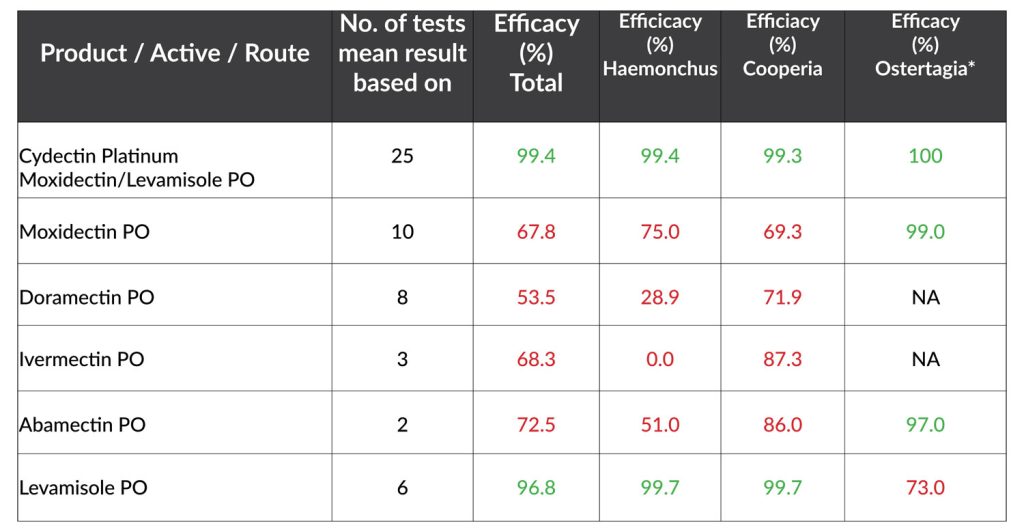A recent scientific article in the Australian Cattle Veterinarians (ACV) journal highlights the need to check that your weaner drench is effective. Drench resistance is widespread in Australia
The ACV Journal Article Outlines Valuable Recent Data From 2018 – 2021 On:
-
- The extent of drench resistance in Australian cattle worms
-
- How different drenches are working against different worm types
-
- Productivity responses when more effective drenches are used on-farm
Effective Drench Programs Are Essntial To Drive Good Productivity In Cattle.
Some important worms in Australian cattle are Barber’s Pole Worm, Cooperia and Ostertagia.5Drench resistance in these worms can lead to a decrease in productivity.
The ACV article collates 25 trial results to show that the overall mean efficacy of single active drenches in Australian cattle can be estimated at only 72%. Drenches need to be working at 95% or better.
NA means there were no larvae of that genus in the faecal culture for that treatment group.

Other key findings include:
-
- Combination drenches, Cydectin Platinum was 99-100% effective against key cattle worms
-
- All single active drenches were not effective against all worms types
-
- Productivity responses when more effective drenches are used on-farm.
The Impact Of Drench Resistance On Cattle Productivity
Over eight weeks, the failure to effectively remove worm burdens in growing cattle can mean a loss of 8-12 kg. This is a problem because investment in genetics and feed may be undermined by failings in the animal health program.
Virbac senior livestock technical services manager Dr Matt Ball encourages farmers to ensure they choose the most effective cattle drench to fight parasites. “We now recognise that single active drenches can no longer effectively control all key worms or protect productivity.”
Combination Drench,Cydectin Platinum, Led To Increased Weight Gain
In 2020-21 James Cook University (Townsville, Northern Australia) and NSW DPI (North Coast, NSW) investigated cattle weight gain following treatment of weaners with different drench products. Cydectin Platinum led to increased weight gain (for example, 8 kg more than doramectin pour-on over 2 months).
Cydectin Platinum
Cydectin Platinum is the next generation pour-on drench for cattle containing moxidectin and levamisole and delivers:
-
- Unrivalled worm control (99-100%), highly effective against single and dual-resistant worms
-
- Short 7 day withholding period
-
- Only combination drenches with persistency – prevents pasture contamination for up to 35 days.
-
- No known impact on dung beetles
It also is the first veterinary use of DMI-SorbTM technology to keep the product concentrated in the areas where it was applied and reduce absorption variability. All in the convenience of an easy to use low volume pour-on.
Switch to Cydectin Platinum Today
Using a of combination drenches should be the default position when chemicals are needed: SWITCH to Cydectin Platinum TODAY
MORE INFORMATION:
au.virbac.com/platinum | 1800 242 100
REFERENCES:
-
- Canton et al (2019) Impact on beef cattle productivity of infection with anthelmintic-resistant nematodes, NZ Veterinary Journal, 68: 187-192.
-
- NSW DPI (2020) Duck Creek Endoparasite Trial – Virbac Data on File. 3. Virbac (2016) Weaner Productivity Trials – Data on File 4. Eppleston & Watt (2016) Post Weaning Growth of beef heifers drenched with long and short-acting anthelmintics, AVJ, 94:341-346. 5.The Australian Society for Parasitology (2014) Australasian Animal Parasites Inside Out. E-Textbook. 6. Sutherland and Leathwick (2011) Anthelmintic resistance in nematode parasites of cattle: a global issue? Trends Parasitol. 27(4):176-81. 7. Rendell et al (2014), Anthelmintic resistance in cattle nematodes on 36 Victorian properties, Proceedings of the 28th World Buiatrics Congress 231–244. 8. Cotter et al (2015), Anthelmintic resistance in nematodes of beef cattle in south-west WA, Veterinary Parasitology 207, 276-284. 9. Lyndal-Murphy et al (2010) Reduced efficacy of ML treatments in controlling gastrointestinal nematode infections of weaner dairy calves in subtropical eastern Australia. Vet Parasitology. 168:146-150. 10.Bullen et al (2016), Anthelmintic resistance in gastrointestinal nematodes of dairy cattle in the Macalister District of Victoria, AVJ 94, 35-41. 11. George M et al (2020) Production impacts and resistance of gastrointestinal parasites in feedlot cattle, MLA: B.FLT.3002. 12. Pritchard & Geary (2019) Perspectives on utility of moxidectin for the control of parasitic nematodes in the face of developing anthelmintic resistance, International Journal for Parasitology- , 10:69-83. 13. Ball and Gibbison (2021), Resistance Patterns to Avermectins and Milbemycins in Australian Cattle Nematodes, ACV Journal Dec 2021.
